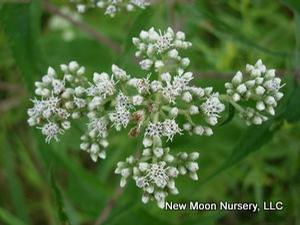New Moon Nurseries
Eupatorium perfoliatum
Boneset
Native to North America
FIRST IMPRESSIONS: Eupatorium perfoliatum is a native rhizomatous perennial with multiple upright stems. The bold leaves are arranged in pairs on the stem. Each pair is perfoliate with bases that merge together and surround the stem. In late summer large terminal flower clusters emerge. The fragrant white blooms attract butterflies and other pollinators. This species thrives in sun to part shade and in moist or wet soils.
HABITAT & HARDINESS: Eupatorium perfoliatum occurs in eastern North America from Nova Scotia to Manitoba and south to Florida and Texas.
Plants are indigenous to stream and river banks, alluvial woods, edges of swamps, marshes, bogs, seeps, openings in bottomland forests, wet areas in Blackland prairies and roadside ditches. This species is generally found in wetlands.
This species is hardy from USDA Zones 4-8.
PLANT DESCRIPTION: Eupatorium perfoliatum is an upright sturdy perennial that forms clumps of unbranched stems.
The stems are covered with long white hairs and large bright green leaves. The leaves are lance shaped, toothed and up to 8” long. They are opposite with bases that are fused together. They wrap around the stem so that the stem appears to pass through the leaves.
The stems terminate in loose flat topped corymbs from 3-8” across. Each corymb is composed of many fragrant white disc florets. Blooming begins in late summer and lasts for 1-2 months.
Clusters of tufted achenes form after flowering.
Some plants are noticeably rhizomatous – forming small colonies.
Plants are 3-5’ tall with a 2’ spread.
CULTURAL & MAINTENANCE NEEDS: Eupatorium perfoliatum prefers full to part sun but will tolerate shadier conditions.
Plants are not particular about soil type. They will thrive in sandy, clay or organic soils as long as moisture is constantly present. This species can even tolerate flooded soils for short times
Plants can be rather tall and lanky but they can be cut back in early spring to promote bushier growth
Plants are pest resistant and foliage is unpalatable to deer and other herbivores.
LANDSCAPE USES: Eupatorium perfoliatum is a dramatic Accent for a Wildlife Garden or moist Meadow. Plants are also used as Butterfly Nectar Plants or as part of a Grouping or Mass Planting. This wildflower offers Showy Blooms and provides Erosion Control. It is useful in Stormwater Retention Basins and Rain Gardens. It can be used in Cottage Gardens, Deer Resistant Plantings, Water-wise Landscapes, Low Maintenance Plantings, Perennial Borders or Shade Gardens.
COMPANION & UNDERSTUDY PLANTS: Try pairing Eupatorium perfoliatum with Aster novae-angliae, Lobelia cardinalis, Monarda fistulosa, Rudbeckia laciniata, Solidago rugosa ‘Fireworks’, Carex amphibola, Carex radiata, Panicum virgatum or Sorghastrum nutans.
Eupatorium purpureum and Eupatorium fistulosum are possible substitutes as they have comparable cultural requirements but both are taller with pink flowers
TRIVIA: Flowers attract butterflies, native bees, pollinating flies, wasps and beetles. Moths of several caterpillars feed on the foliage. Seed are occasionally eaten by swamp sparrows.
The common name Boneset was probably due to the use of the plant in the treatment of an influenza known as “break bone fever”. The disease was said to cause pain that was as intense as the pain from a broken bone. Eupatorium perfoliatum reportedly induced sweating that broke the fever. This species is sometimes called thoroughwort because it has stems that go “through” pairs of perfoliate leaves.
Height:
3-5 ftSpread:
3-4 ftSpacing:
6-8 ftUSDA Hardiness Zone:
4-8Bloom Color:
WhiteEupatorium perfoliatum Characteristics
Attracts Wildlife
- Butterflies
- Pollinators
Attributes
- Dried Flower
- Cut Flower
- Coastal
- Clay Soil
- Naturalizing
- Bog
- Long Blooming
- East-Coast Native
Exposure
- Full Sun to Partial Shade
Deer Resistant
- Deer Resistant
Flowering Months
- September
- August
- July
Foliage Color
- Green
Juglans nigra Tolerance (Black Walnut)
- Yes
Salt Tolerance
- Medium
Soil Moisture Preference
- Wet to Moist
Interesting Notes:
For more information on this plant, visit the USDA PLANTS Database: http://plants.usda.gov/java/profile?symbol=eupe3
